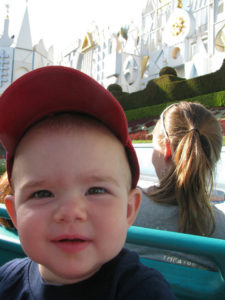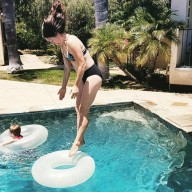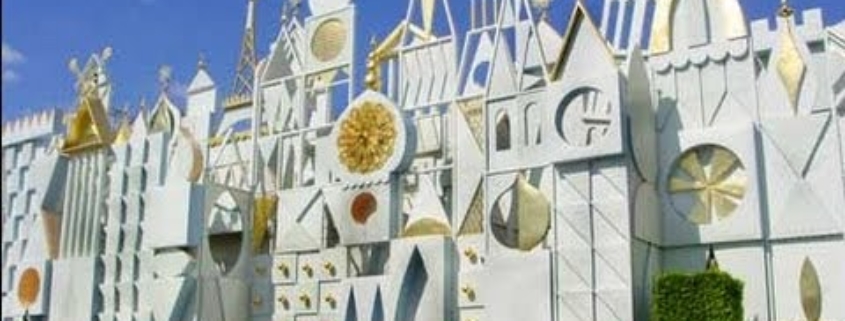Exit Manual
You have a waking nightmare, one that is recurring.

Photo credit: Mary Birnbaum
You find yourself once again among the crowd at Disneyland pushing your small children before you in a double-wide stroller. (No, this is not the extent of the nightmare.) Everyone is steaming; everyone has theme-park fatigue and the solution is always to find a nice long ride, somewhere in the shade. The air is full of burnt sugar and popcorn, hot sunscreen and spilt sticky soda. Jolly music emanates from the bushes or maybe from the sky. Heat beats off the asphalt and off your scalp and you feel the early sting of sunburn on your bare shoulders. You know from experience that the best, coolest place to sit and breastfeed your baby is on It’s a Small World. You know that the five minutes of respite you get inside can feel like heaven. You brace yourself for the ride’s broken record serenade, its small grotesque dolls representing the peoples of the world (their eyes round as bullet holes). You’ve got stroller calluses on your palms and sweat training down your spine and between your milk-fattened breasts and you need to breathe for a few minutes without inhaling cinnamon and baking sunscreen. So you do not care about uncanny dolls. You make your way to the back edge of the park where the ride looms.
The three-year-old will be excited through her lethargy, though she has already been on this ride many times. You live near by. You take your children to Disneyland a lot. You park your stroller and wait in line with a baby on your hip and the three-year old holding your hand. The heat makes all lines feel twice as long. Everyone shuffles forward listlessly, their faces turned to the white facade of the ride, which churns like a great origami machine. There are rolling gears, spinning discs, wheels with gilded edges. A large clown-faced clock ticks in the middle, its arms—like loose blades—swing willy-nilly. Somewhere close a train whistle shrills and you startle.
When you reach the front of the line a blue boat glides forward down the river for you. Each boat is twelve feet long. There are five rows for passengers. You usher your little girl ahead and slide in next to her onto one of the plastic benches. You put your other child, the baby, in your lap. It feels so nice to sit down that your eyes flutter closed for just a moment. Though you haven’t yet entered the ride’s dark tunnel, now that you’re bobbing on chlorinated water you can taste the air conditioning, feel your body cooling. You sit very still, waiting for the boat to drift into the dark so you can pull your breast out to feed the baby. Beside you, your older daughter’s blonde hair is sweaty and dark at her temples and her slick little arm presses against yours. She cranes her neck upward and outward, her eyes wide, waiting for a view of the tunnel. As you float forward you hear her small voice try to name every topiary animal on the banks of the river. One moose-shaped bush, one bear, one deer before you’re inside. Your child’s thigh is pressed to yours and sweat seeps where your bare legs touch.
Once you are swallowed by the tunnel, the air is so cool that breathing feels like drinking water. You can pull down your shirt now, in the dark, to feed that baby. When she is latched, perspiration from you both suctions her hot cheek to your breast and when your milk lets down, the relief very nearly puts you to sleep. But not quite. This is always how it is for you, being with the children; sleep tugs at you constantly and you are rarely able to submit. When you look over at her, you see your toddler’s face is glowing in the ride’s stage lighting, which shoots up from canned spotlights in the floor, shoots down from thirty-foot ceilings, spattering the scenery. The chirping song might be a balm for a while, a lulling chant. Without any apparent geo-political logic, one cardboard country flows into another on the river banks, from room to cavernous room. Instead of trying to understand it, you allow yourself to be beguiled, briefly, in the chaos of noise and color.
There are wooden hills undulating on the right, flat like a stage set, painted plaid, meant to suggest the Scottish Highlands. On the left, frosty white triangles jut upward into peaks evoking (you suppose) the Swiss Alps. Dolls in lederhosen and bearded goats click along animatronically. In the South America room, the song’s lyrics are sung in Spanish. The dolls here are poncho-draped with plastic faces gleaming out from under real straw sombreros. Their jaws clatter open and shut. Their eyes are flat.
In your peripheral vision the neon green exit signs gleam. They lurk in the recesses of the rooms, discreet, so reality barely breaches the clement cruise. But they’re easy to spot, if you’re looking for them. And you will be. Their green-lit capital lettering is unmistakable, waiting like a promise, in case a shot is fired. They mark the doors one must push to open, leaning their body against the cold bar to release the metal catch. You imagine the way that feels. A minute or so into the ride, you find yourself scanning for the exits, actively checking them off in your mind as your boat flows from room to room, from one country to the next.
The child you hold lies heavier now, the way a baby releases its weight in sleep. She has unlatched from your breast. Her mouth makes a little O. You pull your tank top back over your nipple. You are conscious of her weight, as you sometimes are, when you make a silent calculus of how fast and how far you could go, should you need to carry both children at once in a hurry. You think of how to encircle their torsos with your arms, hoisting their sweaty bodies onto your hips with fluid strength.
* * *
As part of maintaining a safe campus community, we ask that you take a moment to view this PowerPoint on active shooter awareness and response measures. Although the likelihood of an active shooter event occurring on campus is remote, AU encourages the community to take an active role in preparing for such an event. Please be aware that this training, in particular the video portion, might be difficult to watch for some individuals.
-—From a November 29th email entitled “Active Shooter Awareness and Response Measures PowerPoint” sent to the entire Antioch University Los Angeles community, citing information from the Department of Homeland Security’s annual campaign.
* * *
You feel the plastic bench lengthen beside you when your daughter moves toward her rail of the boat, excited when she recognizes a familiar Disney character among all the dolls. There’s her little voice again, naming the figures as you float by and part of your mind is glad with her. But overwhelmingly now the exits, like beacons, are center-most in your consciousness. If a gunman opens fire, you know the fate of your children will depend on his proximity and on the type of gun he brought. You think about how, like songs, bullets can come in rounds. He may be in the boat ahead of you or the boat in back. He could be in your boat. He may emerge from within the ride, having chosen this moment after waiting for minutes or hours in a dark cleft of scenery. There are so many places he could hide in the rooms of this ride, beside this fake river, between any of the cardboard countries.
* * *
HOW TO RESPOND when an active shooter is present:
RUN:
- Have an escape route and plan in mind
- Leave your belongings behind
- Keep your hands visible
* * *
The water beneath the boats is shallow and the current is designed to flow lazily, so that the boat will be moving slowly when you need to jump away from it. You will need to gather your children by encircling, hoisting, just as you imagined. You’ll need to hold them firmly and scoot across the bench to the edge of the boat. First you will launch the toddler, then the baby, from the rail onto the banks of the colorful synthetic world. Your older daughter is coordinated enough to stand and to run if you throw her out. Aim for some open space, a gap in the scenery. You will try to stay low when you move.
* * *
HOW TO RESPOND when an active shooter is present (cont’d):
HIDE:
- Hide in an area out of the shooter’s view
- Block entry to your hiding place and lock the doors
- Silence your cell phone and/or pager
* * *
When all three of you are out of the boat, within the scenery, you can cover the bodies of your children with yours so that as little of them is exposed as possible, bunching them together against your heart. You need to make for the exit light.
* * *
HOW TO RESPOND when an active shooter is present (cont’d):
FIGHT:
- As a last resort and only when your life is in imminent danger
- Attempt to incapacitate the shooter
- Act with physical aggression and throw items at the active shooter
* * *
You will waste no time thinking you can disarm the shooter, but there will be panic to contend with, that’s certain. People are going to be terrified in the noise and the chaos. People will clamber to get away, they will tear at one another, run and fall, splash and flail, sob or scream or plead. There will be no music audible over the din of gunshots and panic. You will expect these sounds. You will remember to get your babies out. If the shooter is close, there may be a reality of blood to consider, the smell of it, the quickly cooling warmth. You will still move efficiently, bearing in mind that the blood could be coming from a stranger or you or your child. You may only be able to tell once you get the children out the exit door. Your shirt may be thin enough to rip, should you need to create a tourniquet while you wait for help. There may be many people who need help but your focus must be to put a maximum distance between your babies and the bullets. You’ll have to wait to address any of your wounds. First, you must carry the kids and run far out into the safe, hot light.
* * *
HOW TO RESPOND when law enforcement arrives:
- Avoid quick movements toward officers such as holding on to them for safety [emphasis mine]
- Avoid pointing, screaming or yelling
- Do not stop to ask officers for help or direction when evacuating
* * *
Or the song repeats, uninterrupted by shots or cries, as it has so far. The baby curls against you in her sleep, making a fist with her body. You feel overcome, in the shade at the ride’s end, and you pry that toddler’s hand up off the plastic seat and kiss her moist palm, smell its salty sweetness. You float by the remaining exits. There have been ten of them in all. The glow of the exits weakens as the tunnel reopens. Your boat is flooded by blinding light. You sail out of the song, back again into the day.

Mary Birnbaum is editor of Lunch Ticket’s Diana Woods Memorial Prize in Nonfiction. She holds an MFA from Antioch. She has contributed to Lunch Ticket and The Week. Mary was the 2018 recipient of Disquiet International’s Nonfiction Fellowship and a finalist for Chattahoochee Review’s Lamar York Prize. She resides in Vista, California with her daughters and husband. If you like, you can find her on Twitter @ailishbirnbaum





